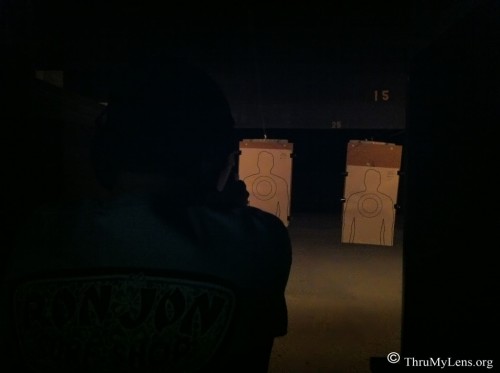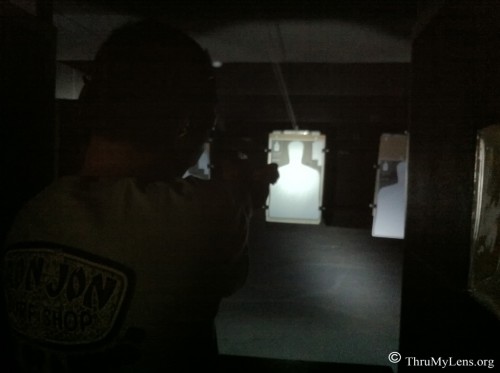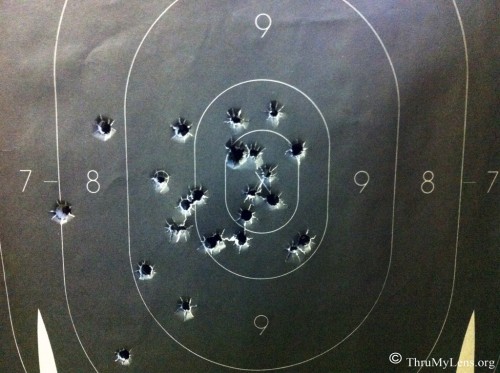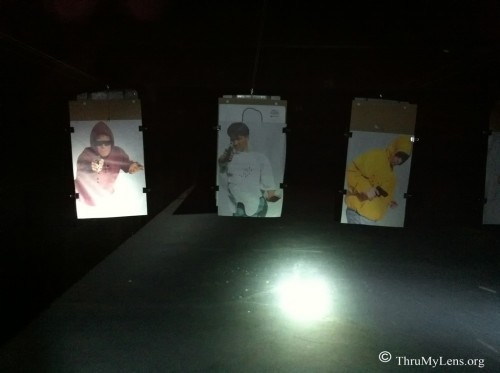This course introduces students to shooting in low light environments. Following instruction on the physiological effects of vision in adverse light settings and the use of flashlights to improve performance, students will complete a course of fire in low light without the use of a flashlight and then with the assistance of a flashlight. Students must provide their own firearm, holster, ear/eye protection, handheld flashlight, and 150 rounds of CleanFire* ammunition.
The course started off as most others have in the class room discussing the importance of training for low-light shooting encounters. The criminal element tends not to operate in broad daylight, preferring the darkness and shadows of night and as a result, most shootings take place at night. Chances are, if you’re in a situation where you’ll need to use your gun, it will be a night, and in less than ideal lighting conditions.
After the classroom discussion, we were taken out on the range, and lights were lowered to simulate the ambient light conditions of a poorly lit parking lot. We were then taken out on the range and shot at a variety of colored targets at both 15 and 25 feet distances. Here’s a photo of my class partner shooting his Glock at a target in this first session so you can get an idea of what kind of enviornment we were shooting in (note that I took all these photos with my iPhone 4, sorry about the quality):
Note the absence of night sights on his firearm. Sim-Trainer recommends that anyone considering taking this course have night sights installed on their firearm. I have Truglo tritium night sights installed on my Springfield Armory XD(m) 4.5 9mm and they make all the difference in the world when it comes to getting an accurate sight picture in low light. I think they actually help in any lighting conditions truth be told.
Once we got a feel for shooting in the dark, we then started incorporating some movement into our drills. After each two-shot salvo, we’d slide a step or two to the right or left. Why? If your target is capable of returning fire after you’ve shot at him, he’ll likely have a good bead on your position based on the muzzle flash from your gun, and the light from your flashlight if you’ve used one. So don’t make it easy on your attacker – shoot then move.
Next up was incorporating a tactical flashlight into our shooting exercises. We went back into the classroom, and instructor Mark Avery demonstrated several different ways to hold a flashlight while you shoot, but recommend the Harries Method, which involves holding the firearm in your strong arm, and your flashlight in your other hand, with the back of your flashlight hand against the back of your strong hand for support. This allows you to train a flashlight on a target, and fire more accurately. We also had a discussion of tactical flashlights, and the features to look for. The thing that separates a tactical flashlight from others is the “instant on/off” tail switch – a tail switch that you can hold down to make the light activate without having to “click it” to activate, and deactivates by simply releasing pressure on the tail switch. In a tactical encounter, a light that stays on when you click it is a liability. Why? Because you want the light on for as little time as possible to take your shot(s), then back off so as not to make it a simple matter for your attacker to shoot back on your position. Flashlight on, get sight alignment on target, take your shot(s), flashlight off, move (don’t forget to move). Under stress, you may inadvertently forget to click off your flashlight – it’s an extra step you don’t need when trying to defend the lives of yourself and/or your loved ones. Prior to this class, I thought that both my Fenix TK12 and my Fenix TK15 were excellent tactical flashlights, but as it turns out, they’re less than ideal. Both have tail switches that have the instant on/off feature, however both can also be “clicked” on with added force. I thought “no sweat, I just won’t push hard enough to click it on.” Wrong. Under stress (and the relatively low-stress training environment was enough to do it for me) you’re going to be pushing that button hard. I found myself inadvertently clicking down the tail switch of my TK12 several times during our excercises. 🙁 Here’s another photo of my class partner, this time shooting with a flashlight:
Here’s a short video which shows him turning on his flashlight, taking his two shots, and then turning off his flashlight (he also moved as he had been instructed but there wasn’t enough light to capture that):
You’ll see that he activates his light, and takes his two shots at the target. What the video cam couldn’t capture is that he did slide to the left after he turned off his light. We both did quite well in the exercise. To save time, we didn’t change out the targets between shooters, but here’s a target which shows our accuracy. My partner was shooting with a .40 cal. glock, so his holes are larger than my 9mm holes – I think I grouped a bit better. 🙂
Our final exercise for the evening was the most challenging. We left the range area and went back into the classroom so the instructors could set up photo realistic targets. We were then lead back into the (dark) range and each shooter was positioned in a stall facing opposite from the target. When all shooters were in place, we then were instructed to close our eyes and turn around so that we’re facing the targets. When we were tapped on the shoulder we could open our eyes, train our firearms and flashlights on the targets and make a shoot/no shoot determination based on the target scene. Here’s a photo which shows an example of some of the targets we shot at:
Not every stall has a target with a bad guy – it was tricky. 🙂
Overall, the course was not only a lot of fun but also very educational for me. It made me think a LOT about my potential response strategy in a shooting scenario, and the equipment I use (like my flashlight). I feel very fortunate to have a facility like Sim-Trainer available to me right here in my backyard of Dayton, Ohio. If you live anywhere near Dayton, I highly recommend you consider the Handgun I-V series of courses which Sim-Trainer offers. If you don’t, definitely see what kind of firearm training is available in your local area, and do seek out some low-light shooting training.






Great post , what a workout ! Now on to T3 starting on the 21st.
One more class and I’ll be ready for the big (T3) leagues!